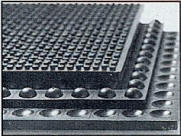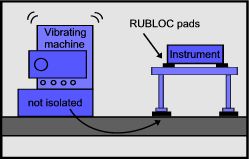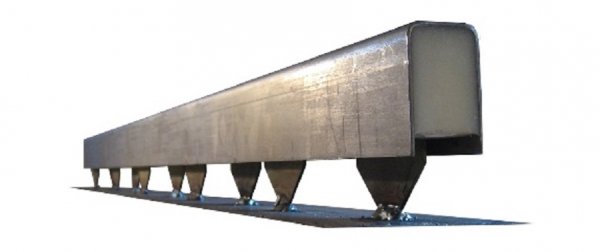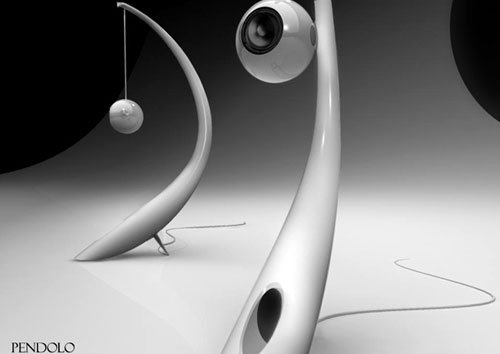I think Alsyvox claims lateral energy of the driver is transmitted with intentional sideways motion via rubber feet.
Their diagram is similar to a building suffering from high winds and or earthquake.
Yes, buildings in earthquake zones may have large rubber like dampeners to control motion and fundamental frequency for motion in all directions (oscillation).
I see this as a sprung wood floor solution common in residential housing.
I think the best method is to design and build a speaker so that it can be placed on either a bouncy wood floor or solid concrete floor, in which case either a Brightstar like energy absorbing base needs to be part of the design, or speaker is supplied with both rubber feet and metal spikes.
As I do not trust people to have common sense my latest design sketches for a loudspeaker feature a built-in mass base of such depth to ensure that the speaker will not be shoved flat agaist a wall. Idiot proof - I hope.
I think that
DaveC and others were attempting to answer my questions in a very simple and non-confrontational manner. This may have lead to some unintentional vagueness that I trust you can work around
stehno.
I am now of the mindset that both rubber feet and metal spikes are the right choice, rubber on sprung floor, spikes on concrete ground slab. However the "rubber" I've used in the past was actually hard plastic so I have some experimenting to do to verify current mindset.
Kach, I understand quite well what others were attempting to do with their responses. I also was not aware that you’re designing speakers. I wouldn’t wanna' waste any more of anybody's time if the topic was trivial as many seem to think. But based on my limited experience, I’d venture that speaker construction, materials, and how it’s connected to the flooring system one can easily realize on average a 10 – 15% overall performance improvement and I’ve done this multiple times. If taken to the extreme (I have not with speakers anyway), I would not be surprised in the least if performance increased to the 25 – 35% range and if so, that’s nothing to sneeze at.
Also, as I’m sure you know, anything that bucks the mainstream mindset is in and of itself confrontational and at some point basic laws and principles must come into play, especially when they are violated.
Anyway, I think the key to your response is your use of the phrase common sense. Which as you seem to imply ain’t so common.
If I was assigned the task to build 48 cubic foot dog house and given a budget of $200 and the only other requirement was that it had to last 50 year minimum, I’d apply my common sense to my design, acquire materials, assemble, paint, and then collect my $200. And perhaps all my family and neighbors would commend me on a job well done.
Then somebody like yourself with an architectural / structural engineering or even a construction background comes by to inspect the dog house. Now your common sense kicks in and you tell me that I’d be lucky if this dog house is still standing in just 1 or 2 years at the most. You list my shortcomings including my use of indoor paint, lack of galvanized nails, untreated wood, no shingles, no corner bracing, no anchoring to the foundation, all the while concluding that I gave this project nothing more than a token effort – from your common sense perspective. But I love this dog house and all my family and neighbors love it too and it even got published in the local newspaper and the feedback there ranked it among the best. Why do they all love it? Could it be because their common sense is much like my own and not like yours?
The point being, we all have varied levels of common sense regarding a subject matter depending on application, requirements, execution, and industry and what we have here is no different.
For example. You choose to use a small high-rise building and how it ought to be anchored to the foundation to make it earthquake proof as your example of performing due diligence.
A high-rise building being a massive load is intended to be anchored in some fashion to a superior foundation (as opposed to an inferior one) which in turn is anchored in some fashion to the earth. The hope being to preserve the building structure and contents in the event of an earthquake by providing some type of energy-absorbing buffer to shield it from the earthquake’s potentially violent and catastrophic energy e.g. rollers, absorbers, etc.
Comparing your model to designing a speaker and anchoring it to the flooring system is IMO comparing apples and oranges with few if any similarities and here’s why:
- The unwanted energy source is in the earth vs in the speaker.
- Even low magnitude earthquakes can be violent enough to collapse some buildings vs no amount of music energy has ever collapsed a speaker’s structure that I’m aware of. That said, to use violent earthquakes and buildings as your model or methodology for designing a speaker is more along the lines of shock and impact vs continuous resonant energy. Shock and impact has nothing whatsoever to with high-end audio and playback performance (leaving TT’s out of the equation), is another subject matter entirely that requires entirely different remedies.
- Unwanted energy should remain in the earth so it cannot induce its catastrophic harm to the building (think isolation) vs unwanted energy at the speaker should transfer to earth before it can induce its harm on the sonics (think energy transfer). Unless one thinks trapping unwanted energy at the speaker is a good thing.
- When oscillation occurs, the building as a whole should move to counter and balance vs we want the speaker to be rigid and unmoving since it’s intended to be a large conduit for mechanical energy to transfer to the earth.
- The building’s integrity should be rigid and structurally sound for unchanging longevity / performance vs the speaker’s integrity should be rigid and structurally sound so as to act as a superior mechanical conduit for which mechanical energy is more free to travel away from the speaker.
- Unwanted energy in the earth seeks to travel away from its point source - stop it vs unwanted energy in the speaker seeks to travel away from its point source - let it. That's what energy wants to do more than anything and is a completely natural behavior. Even if you thought you could win (you can't), why fight it? Let it travel.
In summary, you’ve presented a classic case of isolation vs resonant energy transfer and the two methodologies have nothing in common whatsoever. Can a speaker sound quite musical if inferiorly designed? Happens all the time. Can a speaker sound significantly more musical when superiorly designed? We may never know. But as I’m sure you know, a misapplication of common sense regardless of industry generally guarantees performance opportunities will be kept to a bare minimum at best. And that’s what we’re really talking about here, performance opportunities. Or lack thereof.







